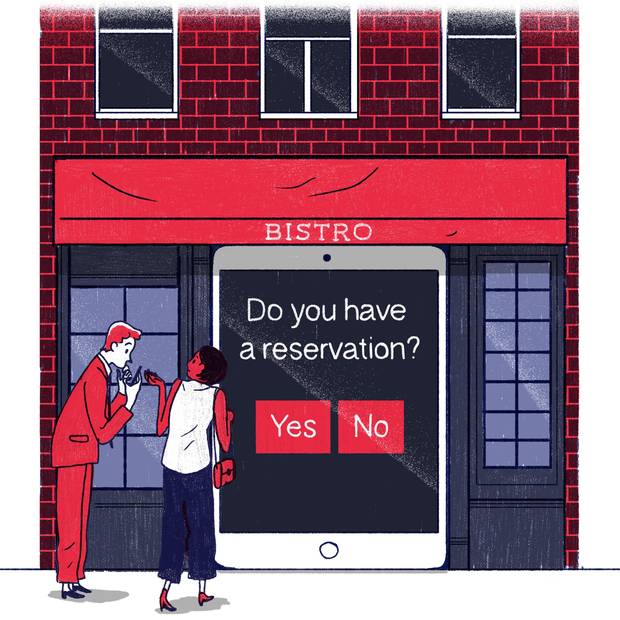In this series, we explore how our online identities intersect with who we really are.
In today's restaurant world, it's unusual to have a human being taking all the reservations. But despite the digital overhauling of our entire culture, some people still do things by hand. Saskatchewan restaurateurs Christie Peters and Kyle Michael are those kind of people.
They butcher whole animals to serve at their Saskatoon spot, The Hollows, which has about 90 seats, plus a private dining room and patio. They also tan the hides and even make soap out of the extra fat.
So it's not really surprising that they think a more personal booking system helps sell their goods.
"For a small business like ours, we feel the direct contact with our customers is worth the extra time," general manager Lacey Sellinger says. "It is nice [for customers] to be able to talk with someone when they are making their reservation."
This used to be standard, of course. You'd call a restaurant, ask for a table and they'd tell you whether or not they could fit you in, often trying to steer you toward an earlier or later dining time to balance out their work flow. Answering machines, which allowed customers to leave requests during off-hours, must have been a boon to the industry when they became common in the 1980s.
The bigger change happened when online reservations became part of our restaurant experience. There are competing technologies, such as Bookenda and DINR, but the industry leader in North America is OpenTable, which launched in Canada in 2002. Within a few years, online booking became an expected component of the dining experience.
Now, restaurants such as The Hollows are definitely in the minority. Even Nora Gray, a popular Montreal restaurant that lasted five years without online reservations, just started using Bookenda in March.
There are upsides to booking services. Customers can book and modify reservations 24 hours a day and restaurateurs can collect valuable data about clientele: birthdays, food likes and dislikes, how they prefer to be addressed.
The downsides are the loss of relationship-building interaction, plus usage fees and, perhaps most important to the bottom line, the rise of no-shows.
"We get a lot of OpenTable no-shows," says Carl Korte, co-owner of Scaramouche in Toronto. "I'm finding that people are doing multiple bookings and not showing up. Not even having the courtesy to call."
Korte uses a blend of analog and digital reservations at his two restaurants: OpenTable for Scaramouche and Bookenda for the Glen Tavern in Georgetown, Ont. Scaramouche has an older clientele, so online booking still only represents about 26 per cent of reservations there. And there are still certain decisions that can't be made by a machine.
"If you talk to anyone running high-end restaurants, we open up a certain amount of inventory for online bookings. What we keep back are the gold times," says Korte, referring to the coveted 7:30 p.m. Friday and Saturday tables that everyone wants. "Because I know that on any given day a regular customer will call us, we have to hold back some inventory."
Adding to the workload is that, despite the technological leg up, Korte gets a staff member to call back to confirm every reservation; conversely, many people who book by phone want an additional digital confirmation. "So you've got more methods to make reservations but still only two hands," Korte says.
Korte estimates that he spends about $17,000 a year on OpenTable. The software embedded in the Scaramouche website costs $49 a month and the restaurants pays $1.25 per diner when guests use the service to book. "Bookenda offers 90 per cent of the service for 10 per cent of the cost," Korte says. "But it doesn't have the reach into the States that I want for tourists and business travellers."
In Vancouver, Chad Clark is a gushing fan of OpenTable. The operations director of Hawksworth and Nightingale says that anyone complaining about price should be getting value from its customer data collection.
"Our regulars, if they set foot in the restaurant, we know what seats they like, what kind of water they drink, what kind of tea they like at the end of the meal," Clark says. "The database of information that we have about all of our regulars is worth its weight in gold."
This sort of information has long been collected by restaurants – it used to be stored in the brain of the owner or host, sometimes scribbled in a book. Now, an iPad prompts even the most novice employee with all of this accumulated data.
But despite his enthusiasm for the software, which is responsible for 60 per cent of his bookings, Clark still employs three people just to handle reservations, answering phones, nine hours a day, plus at least two hosts at each restaurant.
"There is still a generation of people that do not go on the Internet to find things," Clark says.
But the overlap of digital and human reservation methods is not a redundancy, he says. It's a feature, software and humans working in tandem, like a good cop/bad cop dynamic. Savvy customers know to call when they can't get a table online. And smooth hosts know how to be all, "That mean robot wouldn't give you a table? Let me see what I can do."
At high-end restaurants like his, and Scaramouche, an excess of bodies is one of the frills.
Front of house employees aren't robots, just there to take your coat and order. Unlike smaller, louder restaurants, where harried servers rush from table to table, trying to fill in for each other and keep every diner's glass filled, staff are skilled communicators, there to orchestrate a beautiful experience.
Their presence itself is a luxury, one that technology can't replicate.
